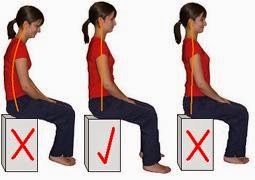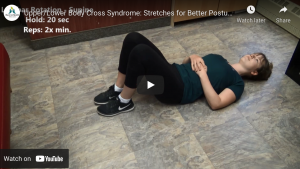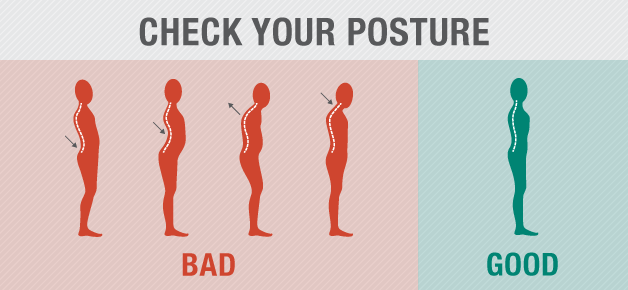Good Posture…just how important is it?
Posture ranks right up at the top of the list when you are talking about good health. It is as important as eating right, exercising, getting a good night’s sleep, and avoiding potentially harmful substances like alcohol, drugs, and tobacco. Good posture is a way of doing things with more energy, less stress, and fatigue. Without good posture, you can’t really be physically fit.
Surprised? Well, you’re not alone. The importance of good posture in an overall fitness program is often overlooked by fitness advisers and fitness seekers alike. In fact, the benefits of good posture may be among the best-kept secrets of the current fitness movement. The good news is that most everyone can avoid the problems caused by bad posture…and you can make improvements at any age.
Watch this video and do these exercises to aid your Posture!
Good Posture is Good Health
We’re a health-conscious society today and good posture is a part of it. Because good posture means your bones are properly aligned and your muscles, joints, and ligaments can work as nature intended. It means your vital organs are in the right position and can function at peak efficiency. Good posture helps contribute to the normal functioning of the nervous system.
Without good posture, your overall health and total efficiency may be compromised. Because the long-term effects of poor posture can affect bodily systems (such as digestion, elimination, breathing, muscles, joints, and ligaments), a person who has poor posture may often be tired or unable to work efficiently or move properly.
Even for younger people, how you carry yourself when working, relaxing or playing can have big effects. Did you know that just fifteen minutes of reading or typing when using the wrong positions exhausts the muscles of your neck, shoulders, and upper back?
 |
| achesawaytoronto.ca |
Poor Posture? How does it happen?
 |
| achesawaytoronto.ca |
Often, poor posture develops because of accidents or falls. But bad posture can also develop from environmental factors or bad habits. This means that you have control.
Today, posture-related problems are increasing:
• As we become a society that watches more television than any previous generation;
• As we become a more electronic society, with more and more people working at sedentary desk jobs or sitting in front of computer terminals;
• As more and more cars are crowding our roads, resulting in accidents and injuries; And as we drive in cars with poorly-designed seats.
In most cases, poor posture results from a combination of several factors, which can include:
• Accidents, injuries, and falls
• Poor sleep support (mattress)
• Excessive weight
• Visual or emotional difficulties
• Foot problems or improper shoes
• Weak muscles, muscle imbalance
• Careless sitting, standing, sleeping habits
• Negative self-image
• Occupational stress
• Poorly designed workspace
Looking for something to correct your posture? Check this out!
 Poor Posture and pain
Poor Posture and pain
A lifetime of poor posture can start a progression of symptoms in the average adult. It can start with…
Fatigue – your muscles have to work hard just to hold you up if you have poor posture. You waste energy just moving, leaving you without the extra energy you need to feel good.
Tight, achy muscles in the neck, back, arms, and legs – by this stage, there may be a change in your muscles and ligaments and you may have a stiff, tight painful feeling. More than 80% of neck and back problems are the result of tight, achy muscles brought on by years of bad posture.
Posture is important to aid in decreasing force on all tendons, muscles, ligaments, and joints of the body!
Joint stiffness and pain – at risk for “wear and tear” arthritis, or what is termed degenerative osteoarthritis. Poor posture and limited mobility increase the likelihood of this condition in later years.
Self-Test for Posture problems
The Wall Test
1. Stand with the back of your head touching the wall and your heels six inches from the baseboard.
2. With your buttocks touching the wall, check the distance with your hand between your lower back and the wall, and your neck and the wall. If you can get within an inch or two at the low back and two inches at the neck, you are close to having excellent posture. If not, your posture may need professional attention to restore the normal curves of your spine.
The Mirror Test
(Front view) Stand facing a full-length mirror and check to see if:
1. Your shoulders are level
2. Your head is straight
3. The spaces between your arms and sides seem equal
4. Your hips are level, your kneecaps face straight ahead
5. Your ankles are straight
(Side View) This is much easier to do with the help of another, or by taking a photo.
Check for the following:
1. Head is erect, not slumping forward or backward
2. Chin is parallel to the floor, not tilting up or down
3. Shoulders are in line with ears, not drooping forward or pulled back
4. Stomach is flat
5. Knees are straight
6. Lower back has a slightly forward curve (not too flat or not curved too much forward, creating a hollow back).
The ‘Jump’ Test
Feel the muscles of your neck and shoulders. Do you find areas that are tender and sensitive? Are the buttock muscles sore when you apply pressure? What about the chest muscles?
Your posture is important when you do everything in your daily life.
It can be worked on via specific stretches for your imbalances, strengthening for the specific areas, treatments that can help you work towards proper alignment of your body.
Watch this video and do these exercises to aid your Posture!
 We can help!
We can help!
Treatments such as orthotic therapy, chiropractic adjustments for the different joints of the body that are affected—from the jaw, neck, mid-back, lower back, shoulders, elbows, wrists, hips, knees, and feet. As well the Active Release technique is very effective in decreasing adhesions due to imbalances and so is massage therapy.


